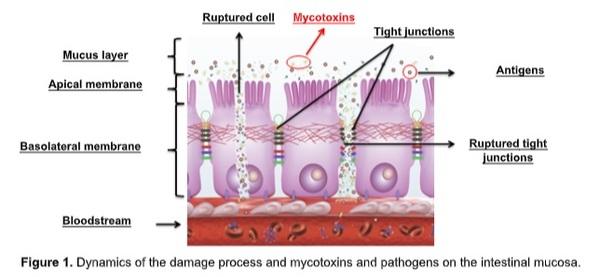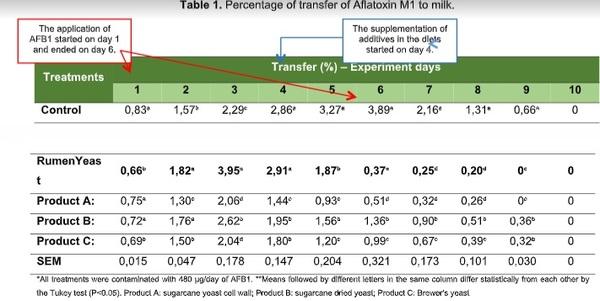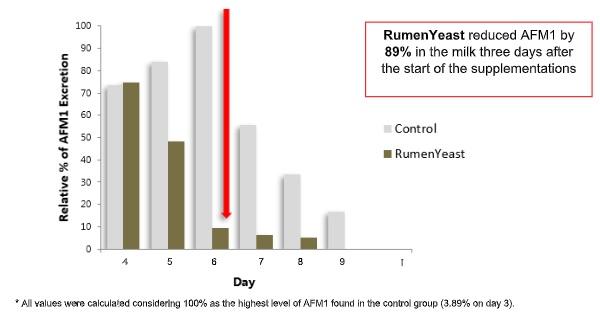Food safety against milk mycotoxins: The guarantee through a natural and efficient solution
from yeast cell walls are capable of binding to different mycotoxins, while α-D-mannans inhibit the toxic activity of mycotoxins, probably by interacting with the radicals of these compounds (Madrigal-Bujaidar et al., 2002).



CREPPY, E.E. Update of survey, regulation and toxic effects of mycotoxins in Europe. Toxicology Letters, v.127, p.19–28, 2002.
DIAS, A. L. G. , FREITAS, J. A., MICAI, B., AZEVEDO, R. A., GRECO, L. F., and SANTOS, J. E. P. Effect of supplemental yeast culture and dietary starch contente on rumen fermentation and digestion in dairy cows. Journal of Dairy Science, v. 101, p. 201–221, 2017. Doi: 10.3168/jds.2017-13241. (a)
Dias, A. L. G. , Freitas, J. A., Micai, B., Azevedo, R. A., Greco, L. F., and Santos, J. E. P. Effects of supplementing yeast culture to diets differing in starch content on performance and feeding behavior of dairy cows. Journal of Dairy Science, v. 101, p. 186–200, 2017. Doi: 10.3168/jds.2017-13240. (b)
FAO. Organização das Nações Unidas para Agricultura e Alimentação. Mycotoxins. Available at: Accessed on: November 26, 2018.
FIRMIN, S.; MORGAVI, D. P.; YIANNIKOURIS, A. and BOUDRA. H. Effectiveness of modified yeast cell wall extracts to reduce aflatoxin B1 absorption in dairy ewes. Journal of Dairy Science, v.94, p.5611–5619, 2011.
GONÇALVES, B. L.; GONÇALVES, J. L.; ROSIM, R. E.; CAPPATO, L. P.; CRUZ, A. G.; OLIVEIRA, C. A. F.; CORASSIN, C. H. Effects of different sources of Saccharomyces cerevisiae biomass on milk production, composition and aflatoxin M1 excretion in milk from dairy cows fed aflatoxin B1. Journal of Dairy Science, v.100(7), p.5701-5708, 2017. doi: 10.3168/jds.2016-12215.
HARTLEY, R.D., NESBITT, B.F., and O’KELLY, J. Toxic metabolites of Aspergillus flavus. Nature. ; 198: 1056–1058. 1963
HARVEY, R.B.; PHILLIPS, T.D.; ELLIS, J.A.; KUBENA, L.F.; HUFF, W.E. and PETERSEN, H.D. Effects on aflatoxin M 1 residues in milk by addition of hydrated sodium calcium aluminosilicate to aflatoxin-contaminated diets of dairy cows. American Journal of Veterinary Research, v.52, p.1556–1559, 1991.
MADRIGAL-BUJAIDAR, E.; MADRIGAL-SANTILLÁN, E.; PAGES, N.; KOGAN, G.; CHAMORRO, G. Antigenotoxic studies in mouse to reduce the aflatoxin B1 damage. In: GOUDEY-PERRIERE, F.; BON, C.; PUISSEUX-DAO, S.; SAUVIAT, M-P. (Eds.). Toxines et Recherches Biomédicales. Paris: Elsevier, 2002. p. 123–132.
OLIVEIRA, C. A. F. and CORASSIN, C. H. Aflatoxins. In: DUARTE, S. C.; PENA, A. L. S. and LINO, C. M. Mycotoxins and Their Implications in Food Safety. London, UK: ed. Future Science Ltd., 2014, p. 6–19.
OLIVEIRA, C. A. F.; CORASSIN, C. H.; CORREA, B. and OSWALD. I. P. Animal health: Mycotoxins. In: Encyclopedia of Agriculture and Food Systems. Oxford, UK: ed. K. Neal and V. Alfen, ed. Elsevier Limited, 2014, p.358–377.
QUEIROZ, O. C. M.; HAN, J. H.; STAPLES, C. R. and ADESOGAN, A. T. Effect of adding a mycotoxin- sequestering agent on milk aflatoxin M1 concentration and the performance and immune response of dairy cattle fed an aflatoxin B1-contaminated diet . Journal of Dairy Science, v.95, p.5901–5908, 2012. doi: 10.3168/jds.2011-5287. USDA. United States Department of Agriculture. Grain, fung diseases and mycotoxin reference. Federal Grain Inspection Service. Washington, D.C. September, 2006.
ZACHARIASOVA, M.; DZUMAN, Z.; VEPRIKOVA, Z.; HAJKOVA, K.; JIRU, M.; VACLAVIKOVA, M.; POSPICHALOVA, M.; FLORIAN, M.; HAJSLOVA, J. Occurrence of multiple mycotoxins in Eurpoe feedingstuffs, assessment of dietary intake by farm animals. Animal Feed Science and Technology, v.193, p.124-140, 2014.








.jpg&w=3840&q=75)